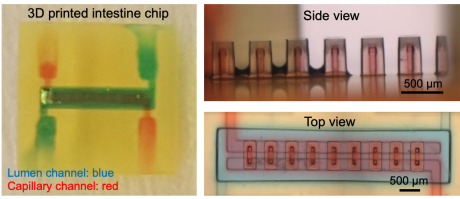Although numerous strategies hitherto have been developed for modeling the gut-barrier, several issues still need to be considered in order to pave the road toward clinical applications. This WP intends to generate a native-like 3D and dynamic gut-on-chip for drug testing and disease modeling. The research will namely focus on (a) using a 3D printing method to establish a microchip, mimicking the human gut-barrier in a more realistic fashion, (b) integrating human endothelial and Caco-2 epithelial cells into the microfluidic channels placed inside the chip, (c) evaluating the drug testing capability of the chip, and (d) using new state-of-the-art imaging facilities (WP5) to gain a mechanistic understanding of the this process.
WP members
Alireza Dolatshahi-Pirouz, Assistant professor
Niels Bent Larsen, Professor
Thomas L. Andresen, Professor
Mehdi Mehrali, Postdoc
Rujing Zhang, Postdoc
Nayere Taebnia, PhD Student,

Figure: The gut-on-a-chip will consist of a lumen channel (gut) and a capillary channel (Top view). The lumen channel will consist of an array of villi similar to the those in the native gut (Side view).